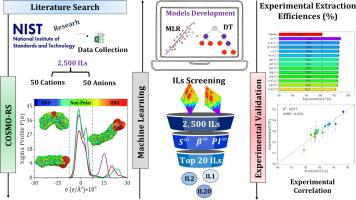当前位置:
X-MOL 学术
›
Chem. Eng. J.
›
论文详情
Our official English website, www.x-mol.net, welcomes your
feedback! (Note: you will need to create a separate account there.)
High-throughput screening of 2,500 ionic liquids for sustainable furfural recovery: Bridging quantum simulations, machine learning, and experimental validation
Chemical Engineering Journal ( IF 13.3 ) Pub Date : 2024-07-14 , DOI: 10.1016/j.cej.2024.153965 Ahmad S. Darwish , Tarek Lemaoui , Hanifa Taher , Inas M. AlNashef , Fawzi Banat
Chemical Engineering Journal ( IF 13.3 ) Pub Date : 2024-07-14 , DOI: 10.1016/j.cej.2024.153965 Ahmad S. Darwish , Tarek Lemaoui , Hanifa Taher , Inas M. AlNashef , Fawzi Banat

|
The recovery of furfural is crucial in reducing reliance on fossil fuels. However, current recovery techniques are inefficient and often use volatile organic compounds (VOCs). In this study, we present a novel approach to identify effective ionic liquids (ILs) as alternative solvents for furfural recovery. For the first time, a comprehensive evaluation of 2,500 ILs was conducted using the COSMO-RS approach, saving time and resources. The results showed that the most effective cations were trihexyltetradecyl phosphonium, tetrabutyl phosphonium, and methyltrioctyl ammonium. The leading anions included bis(pentafluoroethylsulfonyl) imide, bis(trifluoromethylsulfonyl) imide [ntf2], and hexafluorophosphate. This suggests that ILs with hydrophobic and fluorinated anions, combined with large non-polar cations, have the most potential for furfural recovery. Notably, machine learning methods including decision trees and multiple linear regression were innovatively applied to analyze the σ-profiles of the selected 2,500 ILs and assess their impact on extraction. The analysis revealed that cations primarily influenced the distribution ratio, while anions played a significant role in determining the selectivity. To validate the findings, the theoretical predictions were compared with the experimental efficiencies of 13 ntf2-based ILs with different cations. Their performance surpassed that of the benchmark solvent, toluene (81.2%), achieving efficiencies in the range of 91.3% to 94.8%. The comparison also showed a strong correlation between the experimental and theoretical results, with an R2 value of 0.877 and a deviation of 0.24%. This validates the computational approach. These novel findings demonstrate that these ILs outperform toluene in furfural recovery, offering improved efficiency with no drawbacks. They also highlight the transformative potential of computational methods in streamlining the development of sustainable chemical processes.
中文翻译:

高通量筛选 2,500 种离子液体以实现可持续糠醛回收:桥接量子模拟、机器学习和实验验证
糠醛的回收对于减少对化石燃料的依赖至关重要。然而,当前的回收技术效率低下,并且经常使用挥发性有机化合物 (VOC)。在这项研究中,我们提出了一种新方法来识别有效的离子液体(IL)作为糠醛回收的替代溶剂。首次使用 COSMO-RS 方法对 2,500 个 IL 进行综合评估,节省了时间和资源。结果表明,最有效的阳离子是三己基十四烷基鏻、四丁基鏻和甲基三辛基铵。主要阴离子包括双(五氟乙基磺酰基)酰亚胺、双(三氟甲基磺酰基)酰亚胺[ntf2]和六氟磷酸盐。这表明具有疏水性和氟化阴离子的离子液体与大的非极性阳离子结合,最有可能回收糠醛。值得注意的是,创新地应用了包括决策树和多元线性回归在内的机器学习方法来分析所选 2,500 个 IL 的 σ 分布并评估其对提取的影响。分析表明,阳离子主要影响分配比,而阴离子在决定选择性方面发挥着重要作用。为了验证研究结果,将理论预测与 13 种不同阳离子的基于 ntf2 的 IL 的实验效率进行了比较。它们的性能超过了基准溶剂甲苯 (81.2%),实现了 91.3% 至 94.8% 的效率。比较还表明,实验结果与理论结果有很强的相关性,R2值为0.877,偏差为0.24%。这验证了计算方法。 这些新发现表明,这些离子液体在糠醛回收方面优于甲苯,可提高效率且没有任何缺点。他们还强调了计算方法在简化可持续化学过程开发方面的变革潜力。
更新日期:2024-07-14
中文翻译:

高通量筛选 2,500 种离子液体以实现可持续糠醛回收:桥接量子模拟、机器学习和实验验证
糠醛的回收对于减少对化石燃料的依赖至关重要。然而,当前的回收技术效率低下,并且经常使用挥发性有机化合物 (VOC)。在这项研究中,我们提出了一种新方法来识别有效的离子液体(IL)作为糠醛回收的替代溶剂。首次使用 COSMO-RS 方法对 2,500 个 IL 进行综合评估,节省了时间和资源。结果表明,最有效的阳离子是三己基十四烷基鏻、四丁基鏻和甲基三辛基铵。主要阴离子包括双(五氟乙基磺酰基)酰亚胺、双(三氟甲基磺酰基)酰亚胺[ntf2]和六氟磷酸盐。这表明具有疏水性和氟化阴离子的离子液体与大的非极性阳离子结合,最有可能回收糠醛。值得注意的是,创新地应用了包括决策树和多元线性回归在内的机器学习方法来分析所选 2,500 个 IL 的 σ 分布并评估其对提取的影响。分析表明,阳离子主要影响分配比,而阴离子在决定选择性方面发挥着重要作用。为了验证研究结果,将理论预测与 13 种不同阳离子的基于 ntf2 的 IL 的实验效率进行了比较。它们的性能超过了基准溶剂甲苯 (81.2%),实现了 91.3% 至 94.8% 的效率。比较还表明,实验结果与理论结果有很强的相关性,R2值为0.877,偏差为0.24%。这验证了计算方法。 这些新发现表明,这些离子液体在糠醛回收方面优于甲苯,可提高效率且没有任何缺点。他们还强调了计算方法在简化可持续化学过程开发方面的变革潜力。











































 京公网安备 11010802027423号
京公网安备 11010802027423号